The transition from our home in Florida to Grenell in mid-May is sometimes a jarring experience. Last May, our first morning on the island, it was 43 degrees outside and not much warmer inside. When we retired for the evening, I piled the bed with a blanket, a quilt, a comforter and then added an afghan for good measure and could barely turn over all night.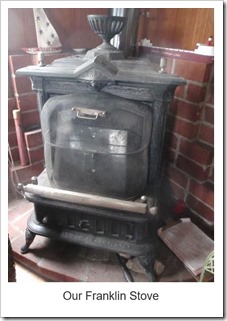
We had a cold May and June last year, with lots of mornings under 60 degrees. There is no insulation in our cottage and we are on the north-east corner of the island. When we have chilly, n’easter winds off the water, it sometimes feels like we don’t have walls at all. On those days, I’m grateful for our little Franklin stove. As far as we know, the Franklin stove is original to our cottage, built in 1895.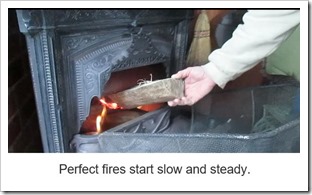
Gary’s parents and grandparents have always referred to black stove in a bricked in corner of the living room as the Franklin stove, though I’m not 100% sure it is a true Franklin stove. Our illustrious founding father, Benjamin Franklin, designed a wood-burning stove back in 1741, that would generate twice as much heat while using one quarter as much wood. Franklin did not want to profit from his invention, but wanted all people to benefit from this new idea, so no patent was taken out on his stove design. Stoves called Franklin stoves aren’t necessarily true Franklin stoves. Our stove doesn’t bear any resemblance to the sketches of Franklin stoves I’ve seen online, but as it has been called a Franklin stove for the last 100+ years, we’ll continue to call it that.
I do know the stove was made by Perry & Co. in Albany, NY because it says so right on the bottom edge. I think it’s a fine stove. To start a fire, we place wood and kindling inside. An air intake at the bottom of the stove slides open and by placing a cover over the opening, air is drawn up from the bottom to make the fire catch quickly. Perfect fires start slow and steady.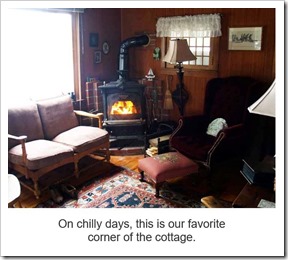
We aren’t the only cottage on the island with a vintage parlor stove, but most islanders use more updated devices to warm their cottages: rolling electric radiators, electric baseboard heat, and wall mounted propane heaters. I know from personal experience of visiting their cottages during cold times, that most of the above methods will warm up a room faster than our little Franklin Stove and can warm the entire room, not just the bricked in corner.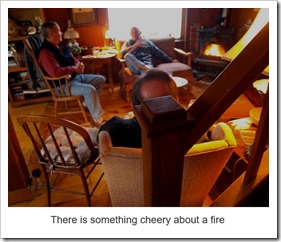
Some neighbors are shocked by our lack of modern heating. I’m often asked what we’ll do if it stays cold for a long time. The answer is: wear a lot of layers and sit closer to the fire. On 40-degree days we will often spend the entire day inches from the Franklin stove. We have a drop leaf table for dinner or a quick game of Qwirkle, our favorite island diversion.
Quick and easy are the catchwords of the day. A stove fire takes time and patience to get started and must be tended to, lest it goes out. Quick? No. Easy. No. But, there is something very cheery about the crackling of logs, flickering of flames and the orange glow of burning wood, not to mention the aroma.
The problem of course is going to bed. The bedroom is upstairs and the stove is downstairs. I know islanders who are addicted to their electric blankets early and late in the season. I worry about EMF (Electric Magnetic Fields) and possible harmful effects I might incur from sleeping under an electric blanket all night.
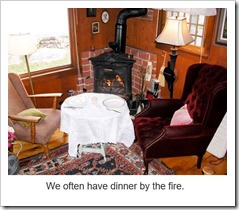 While researching how people stayed warm during Victorian times, I came across an interesting idea, hot water bottles. Victorians usually only had a fire in bedroom fireplaces if someone was ill, otherwise, they not only slept with no heat, but slept with a window open even in the winter as they thought the fresh air was good for one’s health. So Victorians always slept in cold rooms and started their day cold.
While researching how people stayed warm during Victorian times, I came across an interesting idea, hot water bottles. Victorians usually only had a fire in bedroom fireplaces if someone was ill, otherwise, they not only slept with no heat, but slept with a window open even in the winter as they thought the fresh air was good for one’s health. So Victorians always slept in cold rooms and started their day cold. 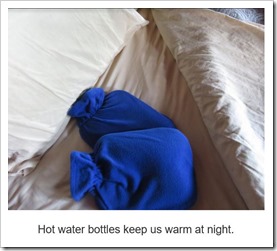
Staying warm through the night was achieved by sleeping in a down feather tick, using hot water bottles to keep warm. The book also described the proper way to fill a hot water bottle, filling it first to warm the rubber, then emptying the contents and adding more hot water once the rubber was warm. This twice fill method reportedly keeps the hot water bottle hotter longer.
I ordered two hot water bottles from Amazon. They arrived with fleece covers that help soften the feel. The first cold night, I prepared the water bottles and placed them in the bed to warm the sheets before we retired. Climbing into pre-warmed sheets was preferable to icy sheets. On super cold nights we each have a water bottle to warm our cold toes and I add a down comforter to help keep us warm. Some nights it wasn’t necessary to use the water bottles after we got in bed. But if we needed them, the water bottles stayed warm all night.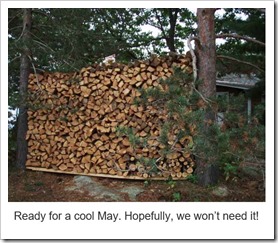
I feel the disapproving glares of some of my non-island friends. Why not just replace those antiquated cottages with a proper and modern vacation home? I can also hear the tsk tsk of some of my island neighbors, who would encourage us not to be so cheap and just get a rolling electric radiator. But we’re not ready to join the 21st Century. To us, staying warm the old-fashioned way with a wood burning fire and hot water bottles is yet another endearing feature to island life. Hopefully, we will have a warmer spring this year, but if not the woodpile is ready and we will start the island season with the sound of crackling fire.
By Lynn McElfresh
Lynn McElfresh is starting the 2017 season like most of us – cold and wet! She also told you in the April 2017 issue that she is a regular contributor to “TI Life” – imagine taking the time to not only find an interesting subject, but to research and write the article, supply the photographs - and they are always relevant - and then supply the captions… not a few times over the years, but every month, without fail, since 2009 – yes 101 issues! You can see all of Lynn’s articles here. (We celebrated her #80 in July, 2015!)